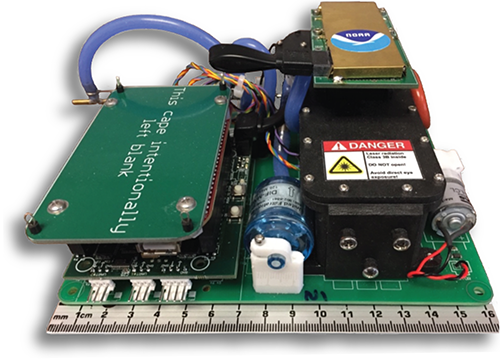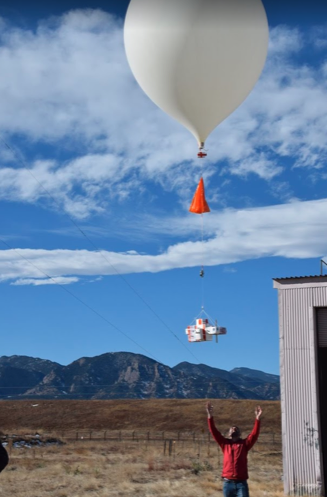Atmospheric Composition & Chemical Processes: Instruments
Portable Optical Particle Spectrometer (POPS)

The Portable Optical Particle Spectrometer (POPS) was developed at the NOAA Chemical Sciences Laboratory (CSL) by Dr. Ru-Shan Gao and his team. The instrument is a robust, small, lightweight, low-power consumption, and relatively low-cost research grade instrument that reports particle size and number concentration of aerosols with diameters between 140 nm and 2.5 µm. This size range captures the bulk of accumulation mode aerosols, which can efficiently scatter light and often outnumber larger aerosols, thereby influencing radiative forcing and Earth's radiation budget.
The instrument boasts single particle detection, a variable flow rate and specialized design features to ensure robust aerosol measurements at high altitude (low pressure). POPS measures the scattered light from a 405 nm (Blu-Ray) laser, each time a particle passes through the beam, and a calibrated Mie theory calculation is used to determine the particle size based on the intensity of scattered light. Like with other optical particle sizing instruments, the calculated size depends on the index of refraction and assumes that particles have a spherical shape.


POPS has flown routinely on small weather balloons, crewed and uncrewed aircraft since 2015, measuring tropospheric and stratospheric aerosol size distributions in both the northern and southern hemispheres. NOAA CSL POPS projects include the Stratospheric Aerosol and Gas Experiment III (SAGE III) validation, Baseline Balloon Stratospheric Aerosol Profiles (B2SAP), and POPSnet-SGP. Routine POPS sonde launches from Boulder, CO, and Lauder, NZ, are timed to coincide with overpasses of the SAGE III instrument onboard the International Space Station to validate its vertically resolved retrievals of stratospheric aerosol extinction. These POPS measurements have captured numerous natural perturbations to stratospheric aerosol in 2019 - 2020, and set the foundation for the B2SAP project. Beginning in June 2020, the frequency of sonde launches from Boulder, CO, has increased to once every two weeks as part of the B2SAP project to establish a detailed baseline of stratospheric aerosol distributions and geophysical variability. POPSnet is a network of POPS distributed across the Aerosol Radiation Measurement Southern Great Plains (ARM-SGP) facility in Oklahoma, deployed to address the representation error in global climate models with regards to background continental aerosol. This project has demonstrated small-scale variability in near surface aerosol distributions across homogenous terrain over several months. Projects in 2020-2023 include the POPS Stratollite Mission, Marion Dufresne Atmospheric Program - Indian Ocean (MAP-IO), and the Air (Ine)quality in New York City pilot study.
Partners on these projects include collaborators in the NOAA Global Monitoring Laboratory, NASA, the Department of Energy, and the University of Leeds, and most recently, World View. NOAA CSL continues to work closely with Handix Scientific, to which the POPS technology was licensed, making the POPS more widely available to the atmospheric science community.
Gao, R.S., H. Telg, R.J. McLaughlin, S.J. Ciciora, L.A. Watts, M.S. Richardson, J.P. Schwarz, A.E. Perring, T.D. Thornberry, A.W. Rollins, M.Z. Markovic, T.S. Bates, J.E. Johnson, and D.W. Fahey, A light-weight, high-sensitivity particle spectrometer for PM2.5 aerosol measurements, Aerosol Science and Technology, doi: 10.1080/02786826.2015.1131809, 2016.
Telg, H., D.M. Murphy, T.S. Bates, J.E. Johnson, P.K. Quinn, F. Giardi, and R.-S. Gao, A practical set of miniaturized instruments for vertical profiling of aerosol physical properties, Aerosol Science and Technology, doi: 10.1080/02786826.2017.1296103, 2017.
Yu, P., K.H. Rosenlof, S. Liu, H. Telg, T.D. Thornberry, A.W. Rollins, R.W. Portmann, Z. Bai, E.A. Ray, Y. Duan, L.L. Pan, O.B. Toon, J. Bian, and R.S. Gao, Efficient transport of tropospheric aerosol into the stratosphere via the Asian summer monsoon anticyclone, Proceedings of the National Academy of Sciences, doi:10.1073/pnas.1701170114, 2017.
Yu, P., O.B. Toon, C.G. Bardeen, Y. Zhu, K.H. Rosenlof, R.W. Portmann, T.D. Thornberry, R.-S. Gao, S.M. Davis, E. Wolf, J. de Gouw, D.A. Peterson, M.D. Fromm, and A. Robock, Black carbon lofts wildfire smoke high into the stratosphere to form a persistent plume, Science, doi: 10.1126/science.aax1748, 2019.